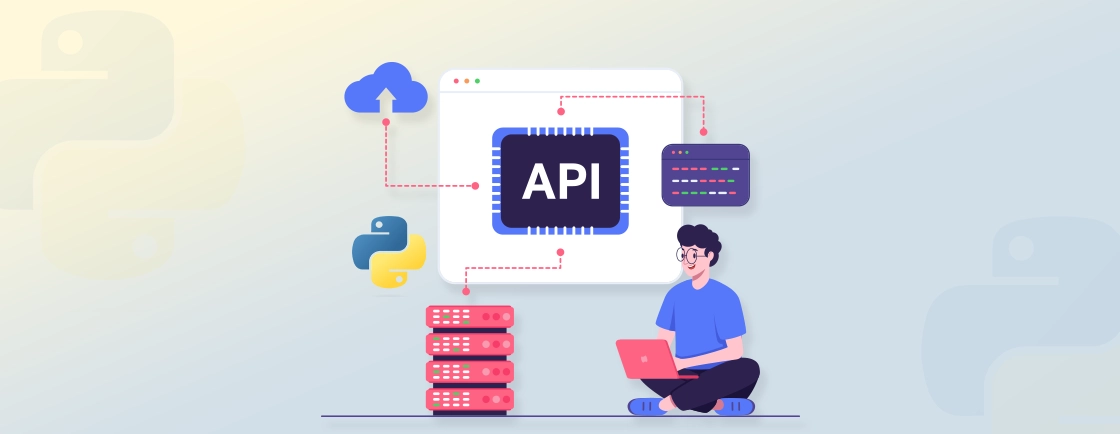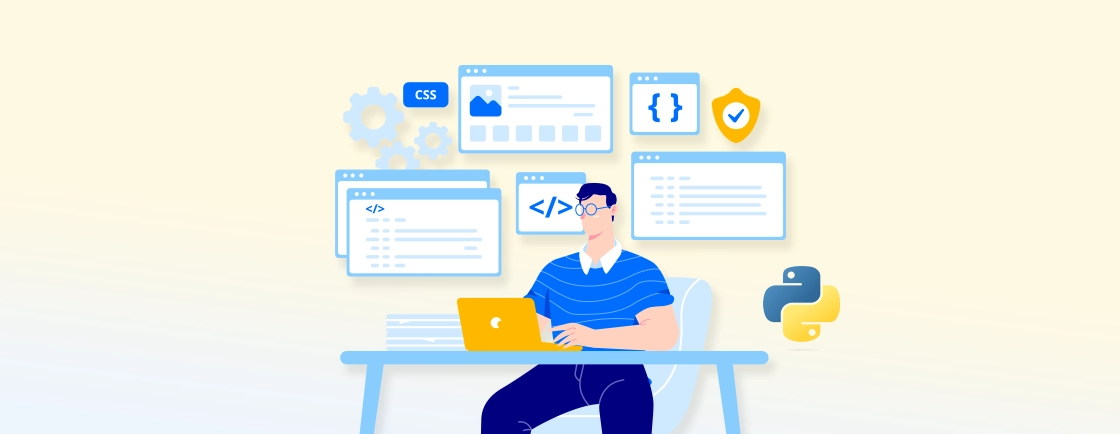Table of Contents
Python is undeniably one of the best server-side programming languages. Part of this success comes from its vast ecosystem of powerful libraries. These are like pre-made building blocks that developers use to tackle complex tasks without reinventing the wheel.
But how do you choose from the most used Python libraries? Which one will be suitable for your web application? Well, the dedicated Python developers consider the top options and evaluate them based on a few key factors.
Through this blog, we’ll shed light on the top Python libraries, see what they can offer you, and how you can choose between them. Let’s begin.
What is a Python Library?
A Python library is like a toolbox filled with pre-written code that you can use in your Python programs. Instead of writing code from scratch for common tasks, you can use the tools (functions and modules) provided in these libraries.
Think of it like this:
- Modules: Individual tools in the toolbox, each designed for a specific task (e.g., a function for calculating square roots).
- Libraries: The entire toolbox, containing many related modules to help you with a broader range of tasks (e.g., a math library with modules for various mathematical operations).
Using the best Python libraries can save time and effort, boost efficiency, and enhance code readability and functionality. If you want to leverage these libraries effectively, consider partnering with an experienced Python Development Company.
Key Features of Python Libraries
Python libraries offer several key features that contribute to their widespread use and effectiveness:
- Modularity: Libraries are organized into modules, promoting code reusability and organization.
- Pre-built functionality: They offer ready-made solutions for common tasks, saving development time.
- Extensibility: Libraries expand Python’s capabilities, enabling complex tasks like data analysis or machine learning.
- Version control: Most libraries use version control systems like Git, so developers can collaborate and easily revert to previous versions if necessary.
- Community-driven: Many libraries benefit from open-source development, ensuring quality and continuous improvement.
- Domain-specific: Libraries cater to diverse fields, from scientific computing to web development.
So the Python experts use them to build high-quality, robust, and scalable websites. But which libraries are the best? Let’s take a look.
Best Python Libraries for Web Developers
With Python, there’s a range of built-in and third-party libraries available with outstanding features and benefits. But which of them will be suitable for building the best web application?
Well, that would depend on your technical requirements. Still, here are 10 of the best Python libraries and popular Python packages preferred by professional web developers.
1. Matplotlib

Matplotlib is a library for creating static, animated, and interactive visualizations in Python. It offers a variety of plots, such as bar charts and scatter plots, to explore and understand data. The customization options allow users to style plots with colors, labels, and annotations.
It integrates well with other libraries like NumPy and pandas. That makes it a key tool for data visualization and analysis in scientific and research applications.
Key Features
- Variety of Plots: Create line plots, scatter plots, bar charts, histograms, pie charts, and more to represent diverse data.
- Customization Options: You can control plot elements like colors, labels, markers, and legends for tailored visualizations.
- Annotation Capabilities: Add text annotations, arrows, and other elements to enhance clarity and highlight specific data points.
- Subplots and Layouts: Arrange multiple plots within a single figure for efficient comparison and presentation.
- Interactive Visualization: Create interactive plots that allow users to zoom, pan, and explore data dynamically.
Ideal for: Data scientists and analysts who must create detailed and customizable visualizations for analysis and presentation.
2. NumPy

NumPy library is the backbone for numerical computing in Python. It provides support for large multi-dimensional arrays and matrices. That includes a vast collection of mathematical functions to operate on these arrays efficiently.
NumPy’s capabilities include broadcasting, vectorization, and integration with Fortran code. Due to its fast and reliable computation, it’s a core library for many other data science and machine learning libraries.
Key Features
- Multi-dimensional Arrays: Efficiently handle and manipulate data structures like matrices and n-dimensional arrays.
- Broadcasting: Perform element-wise operations on arrays of different shapes under certain conditions, simplifying calculations.
- Linear Algebra Functions: Extensive support for matrix operations, vectorized calculations, and algebra algorithms.
- Mathematical Operations: Rich set of mathematical functions for trigonometric functions, statistical functions, and more.
- Random Number Generation: Generate random numbers from various statistical distributions for simulations and data exploration.
Ideal for: Scientists, engineers, and developers who require fast and efficient numerical computations and array manipulations.
3. TensorFlow

TensorFlow is an open-source library for machine learning developed by Google. It offers a flexible ecosystem of tools to build, train, and deploy machine learning models. The library supports various tasks, including neural network training, model optimization, and more.
Its scalability and extensive documentation make it suitable for research and production environments. It’s an essential tool for advancements in artificial intelligence and machine learning.
Key Features
- Flexible Architecture: Build complex deep learning models with layers such as convolutional, recurrent, and dense.
- Automatic Differentiation: Simplifies gradient calculation, a crucial step in training deep learning models by automatically computing gradients.
- TensorBoard Integration: Visualize model training progress, monitor metrics, and analyze model behavior using TensorBoard.
- Production Deployment: Deploy trained models for real-world applications using tools like TensorFlow Serving for inference.
- Pre-trained Models: Leverage pre-trained models for tasks like image recognition or natural language processing as a starting point for fine-tuning.
Ideal for: Machine learning engineers, data scientists, and AI researchers developing and deploying machine learning models.
4. Pandas

Pandas is a data manipulation and analysis library for Python, built on top of NumPy. It introduces two primary data structures: Series (1-dimensional) and DataFrame (2-dimensional). These structures facilitate efficient data handling, cleaning, and transformation.
Pandas offers functions for reading and writing data from various file formats, such as CSV, Excel, and SQL databases. Its robust indexing, merging, and reshaping capabilities make it essential for data science and machine learning projects.
Key Features
- DataFrames and Series: DataFrames for labeled, tabular data and Series for one-dimensional labeled arrays.
- Data Cleaning and Transformation: Offers functionalities for handling missing values, filtering, and transforming data using various methods.
- Indexing and Selection: Efficiently select specific rows, columns, or subsets of data based on various criteria for focused analysis.
- Merging and Joining: Combine data from multiple DataFrames based on shared keys for analysis.
- Time Series Analysis: Provides functionalities for working with time series data, including date/time manipulation and time zone handling.
Ideal for: Data analysts, data scientists, and anyone working with structured data needing efficient data manipulation and analysis.
5. Scikit-Learn

Scikit-Learn is a library for machine learning tasks. It offers a wide range of classification, regression, clustering, and model selection algorithms. Plus, it provides simple and efficient data mining and analysis tools.
It’s known for its user-friendly API and ease of use. Built on NumPy, SciPy, and matplotlib, Scikit-Learn facilitates the development of predictive data models and machine learning applications.
Key Features
- Supervised Learning Algorithms: Implements various algorithms for classification (e.g., Decision Tree) and regression (e.g., Random Forest).
- Unsupervised Learning Algorithms: Offers algorithms for clustering and reducing data complexity.
- Model Selection and Tuning: This includes tools for evaluating model performance using metrics like F-score and hyperparameter tuning for optimal results.
- Feature Engineering: Provides feature scaling, normalization, and transformation tools to improve machine learning model performance.
- Pipelines: Create and manage pipelines that chain data preprocessing steps and model fitting into a single workflow.
Ideal for: Beginners to advanced users in machine learning who need a toolkit for building and evaluating machine learning models.
6. Requests

Requests is a user-friendly HTTP library for Python designed to simplify web requests. It supports HTTP methods such as GET, POST, and PUT and handles cookies, headers, and authentication seamlessly. With its simple API, Requests enables developers to interact with web services and other APIs effortlessly.
It is known for its simplicity and readability, making it a preferred choice for RESTful API interactions and automated web requests.
Key Features
- Simplified HTTP Requests: Send various HTTP requests with minimal code, streamlining communication with web services.
- Automatic JSON Handling: Easily work with JSON data by encoding and decoding data seamlessly.
- Session Management: Manage cookies and sessions to maintain state across multiple HTTP requests. This is essential for user authentication workflows.
- Timeout and Retry Options: Set timeouts for requests to prevent hanging applications and implement retry mechanisms for handling network errors.
- Connection Pooling: Improves performance by reusing existing connections for requests, reducing connection overhead.
Ideal for: Web developers and engineers who need to interact with web APIs and perform web scraping.
7. PyTorch

PyTorch is a dynamic computational graph-based deep learning framework. Developed by Meta’s AI Research lab, it supports GPU acceleration for high-performance computations.
It has a rich ecosystem, including libraries for computer vision and natural language processing. That makes it ideal for developing and prototyping deep learning models.
Key Features
- Dynamic Computational Graph: Build and modify the computational graph during runtime. It allows for flexible experimentation with deep learning models.
- Automatic Differentiation: Similar to TensorFlow, it facilitates gradient calculation for training deep learning models.
- GPU Acceleration: Leverage GPUs for faster training and inference of deep learning models. This improves computational performance significantly.
- Debugging and Profiling Tools: These include tools to debug model training issues and profile code for performance optimization.
Ideal for: Researchers, data scientists, and developers focusing on deep learning and AI research.
8. PySpark

PySpark is the Python API for Apache Spark, a distributed computing system for big data processing and analytics. It enables efficient large-scale data processing capabilities in Python. PySpark supports SQL, streaming data, machine learning, and graph processing.
PySpark integrates with the Hadoop ecosystem, making it suitable for handling vast datasets across clustered environments. Its scalability and speed make it essential for big data applications and real-time data analysis.
Key Features
- Distributed Processing: Process massive datasets by leveraging the power of distributed clusters.
- Fault Tolerance: Provides mechanisms for handling failures. That ensures data processing continues even if nodes in the cluster fail.
- Spark SQL: Offers functionalities for working with structured data using SQL-like syntax.
- Spark Streaming: Enables real-time processing of data streams for real-time analytics on streaming data.
- Integration with Spark MLlib: It provides access to machine learning algorithms in PySpark’s MLlib library for distributed machine learning tasks.
Ideal for: Data engineers and analysts working with big data that require distributed data processing capabilities.
9. Seaborn

Seaborn is a statistical data visualization library based on Matplotlib. It provides a high-level interface for drawing attractive and informative statistical graphics. With minimal code, Seaborn supports complex visualizations like violin plots, heatmaps, and time series plots.
It integrates with pandas DataFrames, simplifying data manipulation and visualization. With built-in themes and color palettes, Seaborn enhances the aesthetic appeal of plots. That makes it a popular choice for exploratory data analysis and presentation.
Key Features
- Statistical Relationships: Visualize relationships between variables using joint and pair plots. They help you to identify correlations or trends.
- Statistical Visualizations: It provides an interface for creating statistical visualizations like box plots, violin plots, and heatmaps.
- Aesthetics and Clarity: Focuses on creating visually appealing and informative visualizations for data exploration.
- Color Palettes: This site offers a collection of color palettes designed for effective data visualization. It ensures a clear distinction between data categories.
- Faceting: Create multiple plots within a single figure based on different data categories. This enables efficient comparison between different categories of data.
Ideal for: Data analysts and scientists who need to quickly create statistically informative and aesthetically pleasing visualizations.
10. SciPy

SciPy is a scientific and technical computing library built on top of NumPy. It provides optimization, integration, interpolation modules, and advanced mathematical functions. SciPy’s capabilities extend to signal processing, linear algebra, and statistical analysis.
It is widely used in industry for scientific research and engineering applications. SciPy enhances NumPy with additional functionality, making it a critical tool for performing comprehensive scientific computations and analyses.
Key Features
- Optimization Algorithms: Offers a variety of optimization algorithms for solving complex optimization problems.
- Integration and Differentiation: Provides functionalities for numerical integration and differentiation.
- Linear Algebra Functions: Includes advanced linear algebra functions beyond NumPy’s core functionalities.
- Special Functions: Provides access to various mathematical functions for various scientific and engineering applications.
- Interpolation: Offers functionalities for interpolating data points to create smoother curves or estimate missing values.
Ideal for: Scientists and engineers needing advanced mathematical tools and scientific computations beyond basic operations.
When trying to create the best Python-based web application, our you should evaluate all these options based on a few key factors and then decides the suitable one.
How to Choose the Best Python Library?
Choosing the right Python library depends heavily on the specific task you’re trying to accomplish. There’s no single “best” library, but rather a best library for your needs. Especially when it comes to Python libraries for web development, developers must evaluate their options based on a few key factors:
Project Requirements
What specific functionalities do you need? Are you building a REST API, handling user authentication, working with databases, or creating a user interface? Match the library’s capabilities to your project’s needs. For example, Flask or Django for web development frameworks, Requests for HTTP requests, or SQLAlchemy for database interactions.
Community and Documentation
A vibrant community means better support, more resources (tutorials, examples), and faster bug fixes. Excellent documentation is crucial for learning and effectively using the library. Check for active forums, up-to-date documentation, and a substantial user base.
Performance
Web applications often need to be performant. Consider the library’s efficiency, especially if you’re dealing with high traffic or complex operations. Look for benchmarks and performance comparisons if available.
Ease of Use/Learning Curve
How easy is it to learn and use the library? A well-designed API and clear documentation can significantly reduce development time. If you’re working on a tight deadline, a library with a gentle learning curve might be preferable.
Integration with Other Libraries
Web development often involves combining multiple tools. Ensure the library integrates well with other libraries you’re using in your project (e.g., database connectors, front-end frameworks).
Security
For web applications, security is critical. If the library handles sensitive data (e.g., user credentials), make sure it has a good security track record and is actively maintained to address vulnerabilities.
Maintenance and Updates
Choose libraries that are actively maintained and regularly updated. This ensures continued support, bug fixes, and access to new features. Check the library’s release history and activity on its repository (e.g., GitHub).
Licensing
Be aware of the library’s license (e.g., MIT, GPL). The license can impact how you can use the library in your project, especially for commercial applications.
Scalability
If you anticipate your web application growing in the future, choose libraries that can scale to handle increased traffic and data volume.
These factors can help you make more informed decisions for your Python-based applications. With the suitable library, you can make sure they are efficient, robust, and maintainable. For better integrity, scalability, and security, consider working with an experienced professionals to build and maintain your solution.
Let’s Conclude the Python Libraries
Python libraries are pre-built modules offering functionalities like streamlining data analysis (with Pandas and NumPy), enabling cutting-edge ML applications (with TensorFlow and PyTorch), and more.
They are designed to simplify complex tasks—and how to leverage their benefits, like increased efficiency and code reusability, is crucial for any Python developer. Choosing the right library depends heavily on your project’s specific needs, but considering factors like community support and performance will help. For web developers, evaluating the most used Python libraries can provide a strong starting point, since these are trusted, well-maintained, and widely adopted by the community.
If you need help with choosing and using the best Python libraries for your web apps, hire Python developers today!
FAQs About Best Python Libraries
How do I install a Python library?
The most common way is using pip, the Python package installer: pip install library_name. For example, to install NumPy, you’d run: pip install numpy.
How do I import a Python library into my code?
Use the import statement: import library_name. You can also import specific functions or modules from a library: from library_name import function_name.
Can I create my own Python library?
Yes! You can organize your code into modules and packages, and then distribute them as a library. This is a great way to reuse your code and share it with others.
Python Solutions for Your Projects
Explore tutorials and resources to master Python for various applications.





